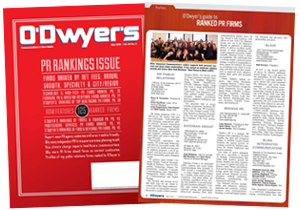 Whether treating injuries and conducting blood drives after natural disasters, tracking the spread of an animal-borne disease or warning of the risks of a severe allergy season, medical providers, epidemiologists, healthcare communicators and other professionals face increasing demands and challenges. Being an effective communicator in this environment requires an understanding of the issues, the role your product or service can play, and how your priorities must evolve to serve stakeholder needs.
Whether treating injuries and conducting blood drives after natural disasters, tracking the spread of an animal-borne disease or warning of the risks of a severe allergy season, medical providers, epidemiologists, healthcare communicators and other professionals face increasing demands and challenges. Being an effective communicator in this environment requires an understanding of the issues, the role your product or service can play, and how your priorities must evolve to serve stakeholder needs.
Whether you believe climate change is natural or man-made, the reality is that climate change is upon us. And while it is a global phenomenon, its consequences are felt in local communities by real people. The Environmental Protection Agency has identified four major climate change concerns and their potential impact on everyday life:
Heat waves
|
|
Climate change is predicted to cause more frequent, more severe and longer heat waves in the summer, which can lead to heat stroke and dehydration. Major heat waves made headlines around the world in the past several decades. Young children, older adults, people with medical conditions and the poor are especially vulnerable.
Reduced air quality
Scientists say warmer temperatures will increase the frequency of days with unhealthy levels of ground-level ozone that can damage lung tissue, reduce lung function, increase respiratory symptoms and aggravate asthma. It is particularly harmful to children, older adults, outdoor workers and those with asthma and chronic lung diseases. Climate change can also increase fine particles in the atmosphere that, when inhaled, can aggravate cardiovascular and respiratory diseases.
Climate-sensitive diseases
Warmer climates may enhance the spread of diseases transmitted through food, water and animals, such as deer, birds, mice and insects. Examples are salmonella and other food poisoning bacteria that grow rapidly in warm environments, water-borne diseases caused by flooding and storm water runoff, and diseases such as West Nile virus and Lyme disease carried by insects.
Extreme weather events
As evidenced by the recent and dramatic consequences of the California droughts, extreme weather events can wreak havoc on millions of lives in a matter of hours. The frequency and intensity of extreme precipitation events are projected to increase in some locations, as is the severity of tropical storms, and these events can threaten human health in myriad ways.
What’s being done
The World Health Organization adopted a work plan in 2009 to support its member states in protecting human health from the effects of climate change. Among their priorities are to raise awareness of climate risks, develop partnerships to increase knowledge and best practices, improve understanding of the linkages between health and climate, and strengthen health systems.
The Centers for Disease Control and Prevention established its Climate and Health Program in 2009 to identify populations vulnerable to climate change, prevent and adapt to current and anticipated health impacts, and assure systems are in place to detect and respond to current and emerging health threats. In 2015, CDC published The Building Resilience Against Climate Effects framework, a five-step process that allows health officials to develop strategies and programs to help communities prepare for the health effects of climate change.
The healthcare industry as a whole can focus its efforts and priorities in three key areas:
• Research. A better understanding of the complicated links between human and natural systems is needed to develop prevention strategies and health incident responses. More research is also needed on the complex interplay between risk, location and environmental conditions, i.e., just how climate change affects people locally. This will guide the development of tools to help communities respond to their particular situations.
• Cooperation. Collaboration between agencies, providers, nonprofit groups and other healthcare stakeholders is essential. Such partnerships can help identify and allocate resources to people who are most vulnerable to the harmful effects of climate change.
• Education. Knowledge is one of the most powerful weapons in battling health problems in any environment. Helping people understand and prepare for climate change health risks is crucial, especially when many ignore, doubt or feel helpless against the phenomenon. Communication and early warnings to highly vulnerable populations, including children and the elderly, are especially important.
Climate and healthcare communications
As climate change comes to the forefront of the healthcare conversation, pharmaceutical companies have an opportunity to reinforce their positions as expert authorities and reliable information sources. Here are guidelines for approaching the topic credibly and responsibly:
• An article in the American Journal of Public Health noted that communication among healthcare agencies, businesses and other stakeholders is essential to evaluating the industry’s response to climate change issues. The development of new and better drugs for the cause should be informed by input from healthcare professionals and ongoing assessments of the most vulnerable populations.
• Pharmaceutical companies must stay abreast of current and pending regulations on emissions and other global warming mitigation actions, and be vocal and accountable stakeholders.
• Every company must be transparent about its contribution to climate change, both to preserve business and fulfill an ethical pledge. Public relations initiatives are essential to communicating environmentally responsible initiatives and commitments.
The healthcare industry is a major force in reducing the human health ramifications of climate change. By understanding the science, preparing for the challenges already being experienced around the world and working proactively to mitigate risks, the sector can be a major contributor to climate change solutions.
* * *
Jeanine O’Kane is Managing Director of Biosector 2 New York, which is part of inVentiv Health.



 Lo Isidro, senior director at Real Chemistry with more than a decade of strategic communications and PA experience, has joined Narrative Strategies.
Lo Isidro, senior director at Real Chemistry with more than a decade of strategic communications and PA experience, has joined Narrative Strategies. Nelson Fernandez, former North American chair of APCO Worldwide and managing director of Burson-Marsteller, has joined Volunteers in Medicine Berkshires as director of communications and PA.
Nelson Fernandez, former North American chair of APCO Worldwide and managing director of Burson-Marsteller, has joined Volunteers in Medicine Berkshires as director of communications and PA. Lilit Bargar, who was most recently an EVP in the healthcare practice at Weber Shandwick, comes on board at GCI Health as EVP, corporate practice lead.
Lilit Bargar, who was most recently an EVP in the healthcare practice at Weber Shandwick, comes on board at GCI Health as EVP, corporate practice lead.
 Five ways that successful thought leaders are made.
Five ways that successful thought leaders are made.


 Have a comment? Send it to
Have a comment? Send it to 
No comments have been submitted for this story yet.